Public Transportation versus Private Transportation
VerifiedAdded on 2023/05/28
|8
|1693
|290
AI Summary
The paper aims to distinguish between public transportation and private transportation, and find out which benefits the economy of a country more. In doing this, the paper will first provide a brief description of public transportation and private transportation. This will be followed by reasons behind the provision of transportation in cities all over the world. Further, the essay will analyze the economic value of providing transportation to people.
Contribute Materials
Your contribution can guide someone’s learning journey. Share your
documents today.
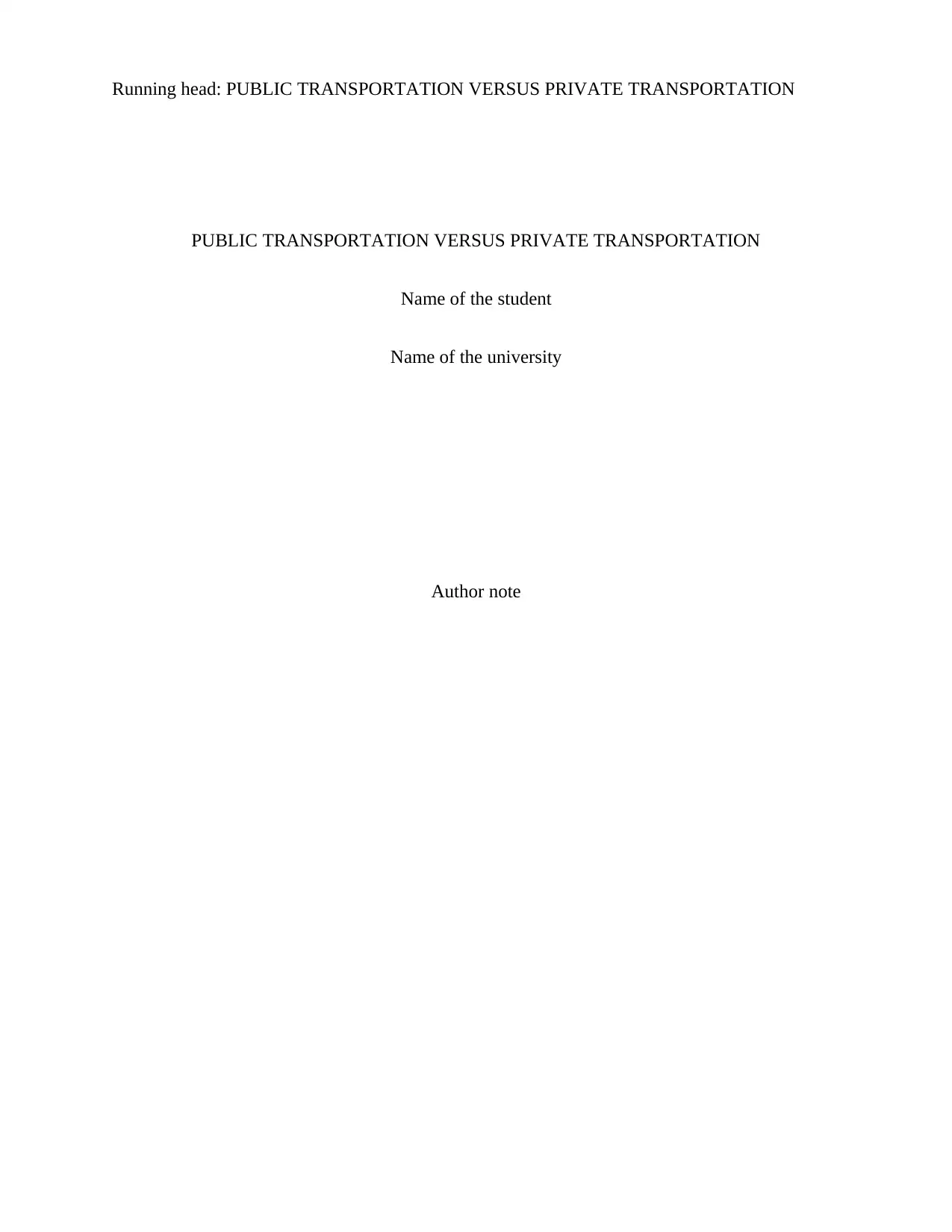
Running head: PUBLIC TRANSPORTATION VERSUS PRIVATE TRANSPORTATION
PUBLIC TRANSPORTATION VERSUS PRIVATE TRANSPORTATION
Name of the student
Name of the university
Author note
PUBLIC TRANSPORTATION VERSUS PRIVATE TRANSPORTATION
Name of the student
Name of the university
Author note
Secure Best Marks with AI Grader
Need help grading? Try our AI Grader for instant feedback on your assignments.
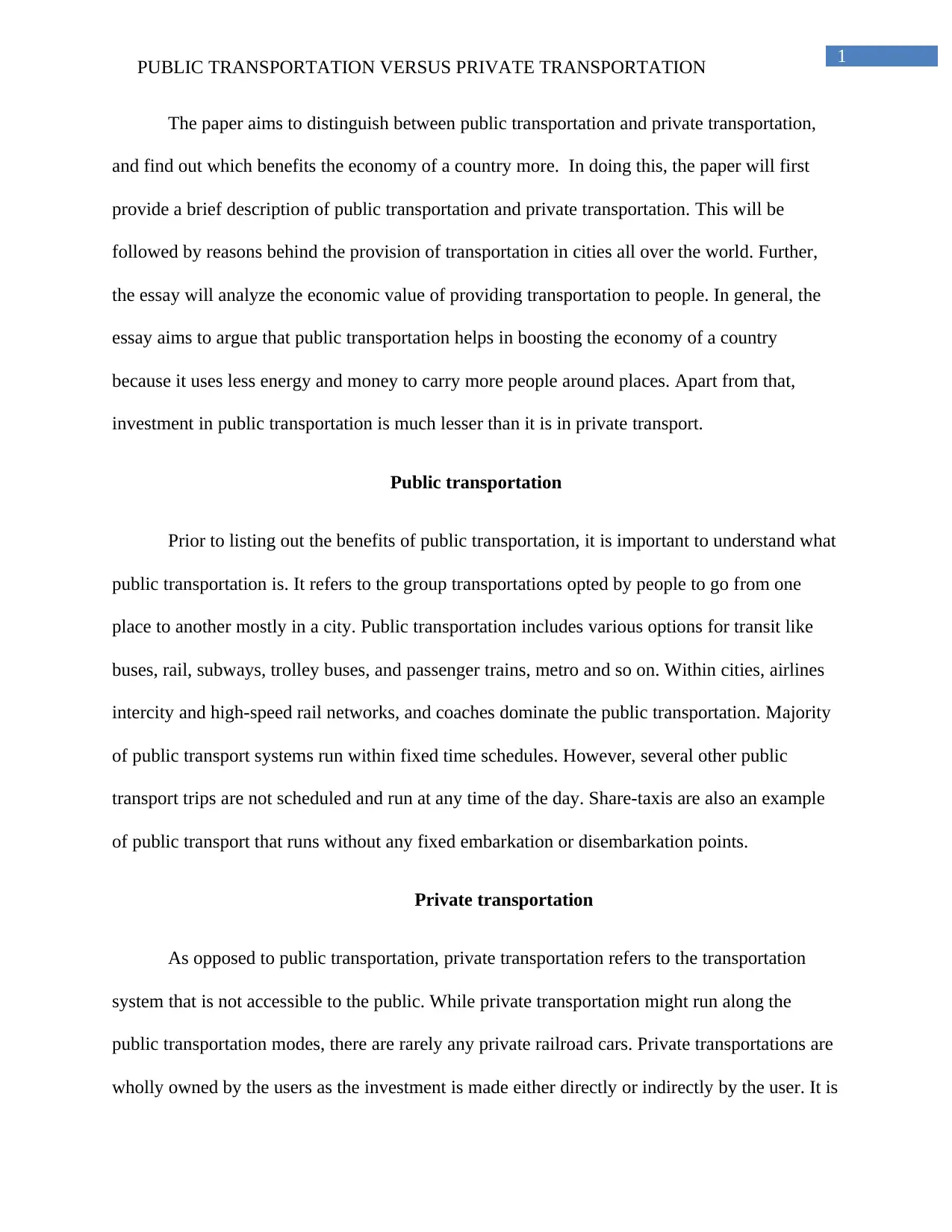
1
PUBLIC TRANSPORTATION VERSUS PRIVATE TRANSPORTATION
The paper aims to distinguish between public transportation and private transportation,
and find out which benefits the economy of a country more. In doing this, the paper will first
provide a brief description of public transportation and private transportation. This will be
followed by reasons behind the provision of transportation in cities all over the world. Further,
the essay will analyze the economic value of providing transportation to people. In general, the
essay aims to argue that public transportation helps in boosting the economy of a country
because it uses less energy and money to carry more people around places. Apart from that,
investment in public transportation is much lesser than it is in private transport.
Public transportation
Prior to listing out the benefits of public transportation, it is important to understand what
public transportation is. It refers to the group transportations opted by people to go from one
place to another mostly in a city. Public transportation includes various options for transit like
buses, rail, subways, trolley buses, and passenger trains, metro and so on. Within cities, airlines
intercity and high-speed rail networks, and coaches dominate the public transportation. Majority
of public transport systems run within fixed time schedules. However, several other public
transport trips are not scheduled and run at any time of the day. Share-taxis are also an example
of public transport that runs without any fixed embarkation or disembarkation points.
Private transportation
As opposed to public transportation, private transportation refers to the transportation
system that is not accessible to the public. While private transportation might run along the
public transportation modes, there are rarely any private railroad cars. Private transportations are
wholly owned by the users as the investment is made either directly or indirectly by the user. It is
PUBLIC TRANSPORTATION VERSUS PRIVATE TRANSPORTATION
The paper aims to distinguish between public transportation and private transportation,
and find out which benefits the economy of a country more. In doing this, the paper will first
provide a brief description of public transportation and private transportation. This will be
followed by reasons behind the provision of transportation in cities all over the world. Further,
the essay will analyze the economic value of providing transportation to people. In general, the
essay aims to argue that public transportation helps in boosting the economy of a country
because it uses less energy and money to carry more people around places. Apart from that,
investment in public transportation is much lesser than it is in private transport.
Public transportation
Prior to listing out the benefits of public transportation, it is important to understand what
public transportation is. It refers to the group transportations opted by people to go from one
place to another mostly in a city. Public transportation includes various options for transit like
buses, rail, subways, trolley buses, and passenger trains, metro and so on. Within cities, airlines
intercity and high-speed rail networks, and coaches dominate the public transportation. Majority
of public transport systems run within fixed time schedules. However, several other public
transport trips are not scheduled and run at any time of the day. Share-taxis are also an example
of public transport that runs without any fixed embarkation or disembarkation points.
Private transportation
As opposed to public transportation, private transportation refers to the transportation
system that is not accessible to the public. While private transportation might run along the
public transportation modes, there are rarely any private railroad cars. Private transportations are
wholly owned by the users as the investment is made either directly or indirectly by the user. It is
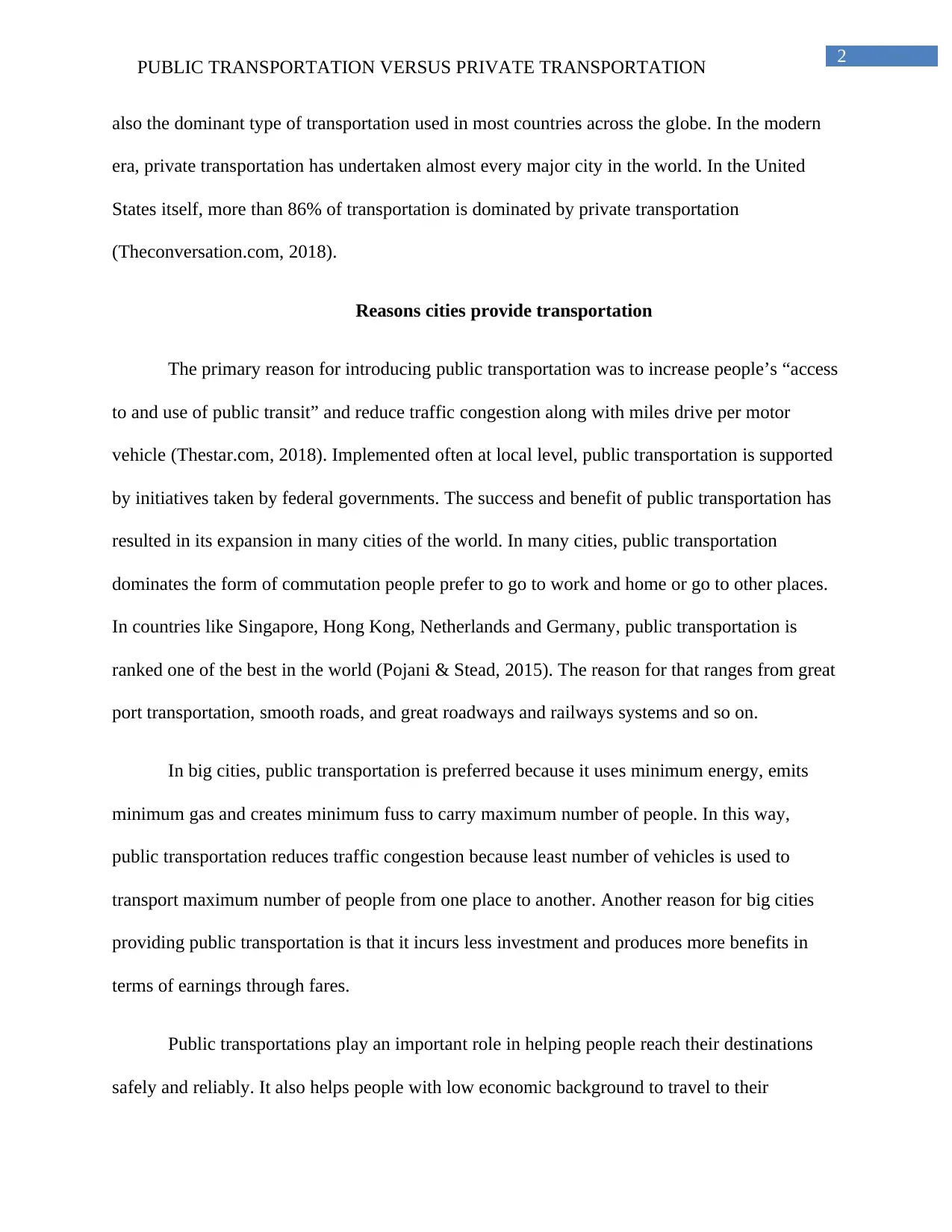
2
PUBLIC TRANSPORTATION VERSUS PRIVATE TRANSPORTATION
also the dominant type of transportation used in most countries across the globe. In the modern
era, private transportation has undertaken almost every major city in the world. In the United
States itself, more than 86% of transportation is dominated by private transportation
(Theconversation.com, 2018).
Reasons cities provide transportation
The primary reason for introducing public transportation was to increase people’s “access
to and use of public transit” and reduce traffic congestion along with miles drive per motor
vehicle (Thestar.com, 2018). Implemented often at local level, public transportation is supported
by initiatives taken by federal governments. The success and benefit of public transportation has
resulted in its expansion in many cities of the world. In many cities, public transportation
dominates the form of commutation people prefer to go to work and home or go to other places.
In countries like Singapore, Hong Kong, Netherlands and Germany, public transportation is
ranked one of the best in the world (Pojani & Stead, 2015). The reason for that ranges from great
port transportation, smooth roads, and great roadways and railways systems and so on.
In big cities, public transportation is preferred because it uses minimum energy, emits
minimum gas and creates minimum fuss to carry maximum number of people. In this way,
public transportation reduces traffic congestion because least number of vehicles is used to
transport maximum number of people from one place to another. Another reason for big cities
providing public transportation is that it incurs less investment and produces more benefits in
terms of earnings through fares.
Public transportations play an important role in helping people reach their destinations
safely and reliably. It also helps people with low economic background to travel to their
PUBLIC TRANSPORTATION VERSUS PRIVATE TRANSPORTATION
also the dominant type of transportation used in most countries across the globe. In the modern
era, private transportation has undertaken almost every major city in the world. In the United
States itself, more than 86% of transportation is dominated by private transportation
(Theconversation.com, 2018).
Reasons cities provide transportation
The primary reason for introducing public transportation was to increase people’s “access
to and use of public transit” and reduce traffic congestion along with miles drive per motor
vehicle (Thestar.com, 2018). Implemented often at local level, public transportation is supported
by initiatives taken by federal governments. The success and benefit of public transportation has
resulted in its expansion in many cities of the world. In many cities, public transportation
dominates the form of commutation people prefer to go to work and home or go to other places.
In countries like Singapore, Hong Kong, Netherlands and Germany, public transportation is
ranked one of the best in the world (Pojani & Stead, 2015). The reason for that ranges from great
port transportation, smooth roads, and great roadways and railways systems and so on.
In big cities, public transportation is preferred because it uses minimum energy, emits
minimum gas and creates minimum fuss to carry maximum number of people. In this way,
public transportation reduces traffic congestion because least number of vehicles is used to
transport maximum number of people from one place to another. Another reason for big cities
providing public transportation is that it incurs less investment and produces more benefits in
terms of earnings through fares.
Public transportations play an important role in helping people reach their destinations
safely and reliably. It also helps people with low economic background to travel to their
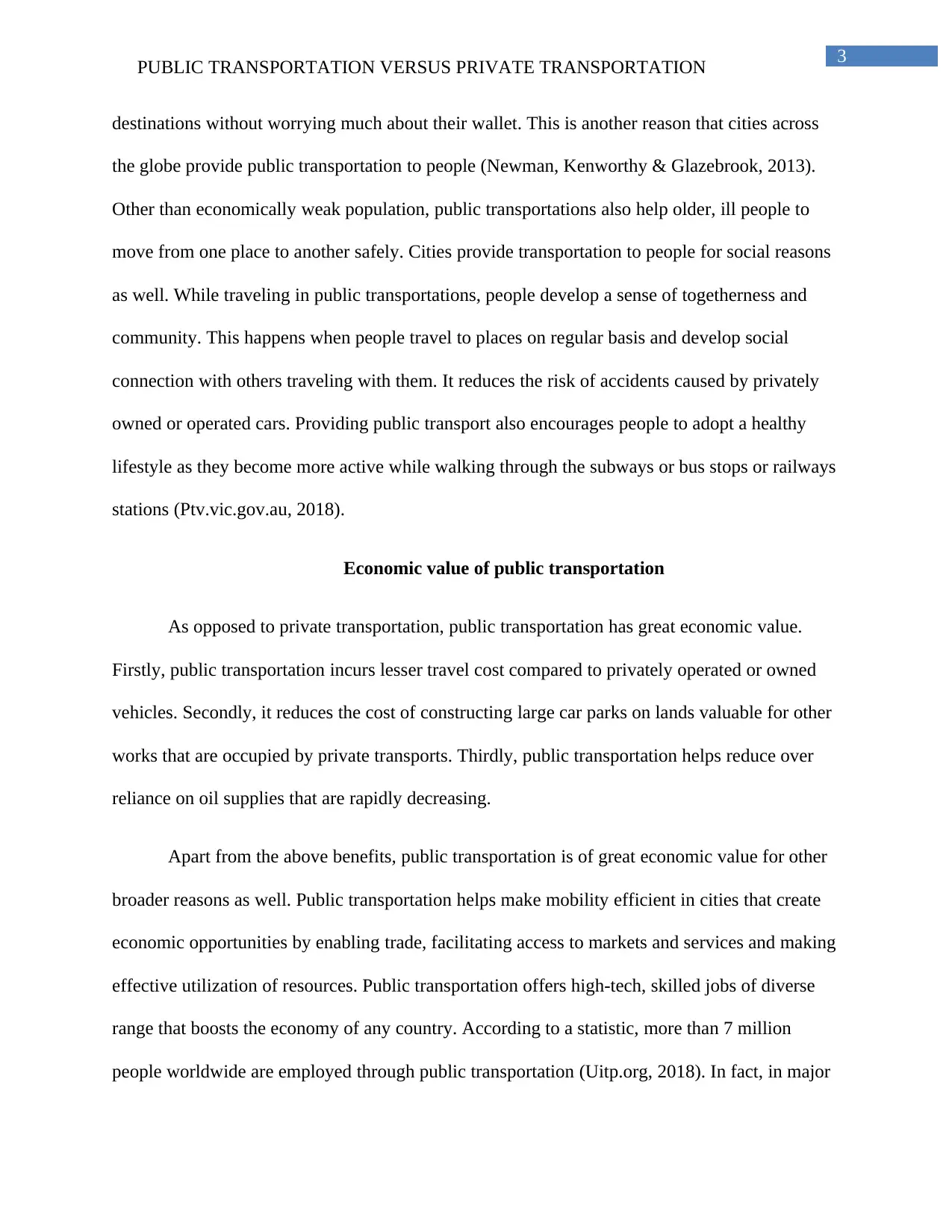
3
PUBLIC TRANSPORTATION VERSUS PRIVATE TRANSPORTATION
destinations without worrying much about their wallet. This is another reason that cities across
the globe provide public transportation to people (Newman, Kenworthy & Glazebrook, 2013).
Other than economically weak population, public transportations also help older, ill people to
move from one place to another safely. Cities provide transportation to people for social reasons
as well. While traveling in public transportations, people develop a sense of togetherness and
community. This happens when people travel to places on regular basis and develop social
connection with others traveling with them. It reduces the risk of accidents caused by privately
owned or operated cars. Providing public transport also encourages people to adopt a healthy
lifestyle as they become more active while walking through the subways or bus stops or railways
stations (Ptv.vic.gov.au, 2018).
Economic value of public transportation
As opposed to private transportation, public transportation has great economic value.
Firstly, public transportation incurs lesser travel cost compared to privately operated or owned
vehicles. Secondly, it reduces the cost of constructing large car parks on lands valuable for other
works that are occupied by private transports. Thirdly, public transportation helps reduce over
reliance on oil supplies that are rapidly decreasing.
Apart from the above benefits, public transportation is of great economic value for other
broader reasons as well. Public transportation helps make mobility efficient in cities that create
economic opportunities by enabling trade, facilitating access to markets and services and making
effective utilization of resources. Public transportation offers high-tech, skilled jobs of diverse
range that boosts the economy of any country. According to a statistic, more than 7 million
people worldwide are employed through public transportation (Uitp.org, 2018). In fact, in major
PUBLIC TRANSPORTATION VERSUS PRIVATE TRANSPORTATION
destinations without worrying much about their wallet. This is another reason that cities across
the globe provide public transportation to people (Newman, Kenworthy & Glazebrook, 2013).
Other than economically weak population, public transportations also help older, ill people to
move from one place to another safely. Cities provide transportation to people for social reasons
as well. While traveling in public transportations, people develop a sense of togetherness and
community. This happens when people travel to places on regular basis and develop social
connection with others traveling with them. It reduces the risk of accidents caused by privately
owned or operated cars. Providing public transport also encourages people to adopt a healthy
lifestyle as they become more active while walking through the subways or bus stops or railways
stations (Ptv.vic.gov.au, 2018).
Economic value of public transportation
As opposed to private transportation, public transportation has great economic value.
Firstly, public transportation incurs lesser travel cost compared to privately operated or owned
vehicles. Secondly, it reduces the cost of constructing large car parks on lands valuable for other
works that are occupied by private transports. Thirdly, public transportation helps reduce over
reliance on oil supplies that are rapidly decreasing.
Apart from the above benefits, public transportation is of great economic value for other
broader reasons as well. Public transportation helps make mobility efficient in cities that create
economic opportunities by enabling trade, facilitating access to markets and services and making
effective utilization of resources. Public transportation offers high-tech, skilled jobs of diverse
range that boosts the economy of any country. According to a statistic, more than 7 million
people worldwide are employed through public transportation (Uitp.org, 2018). In fact, in major
Secure Best Marks with AI Grader
Need help grading? Try our AI Grader for instant feedback on your assignments.
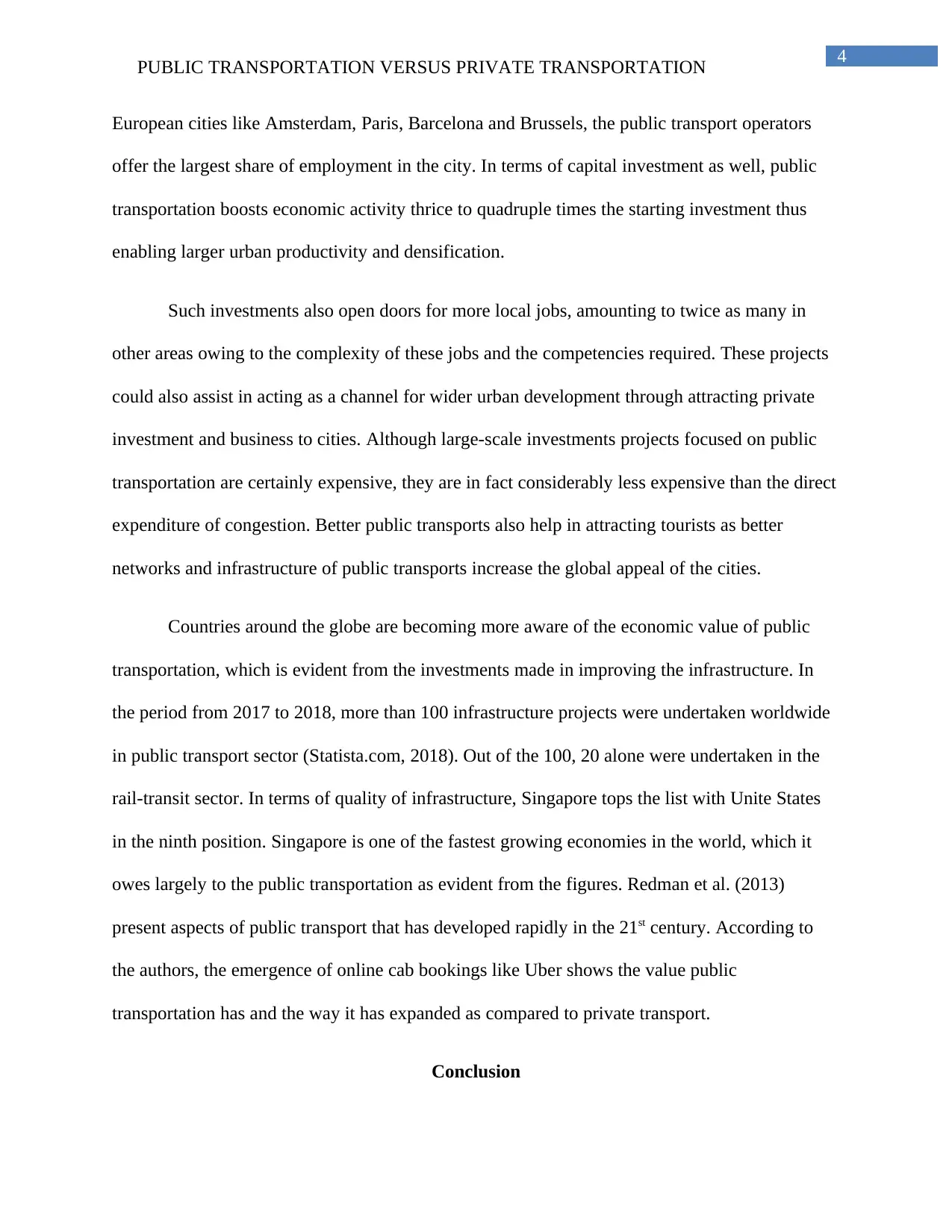
4
PUBLIC TRANSPORTATION VERSUS PRIVATE TRANSPORTATION
European cities like Amsterdam, Paris, Barcelona and Brussels, the public transport operators
offer the largest share of employment in the city. In terms of capital investment as well, public
transportation boosts economic activity thrice to quadruple times the starting investment thus
enabling larger urban productivity and densification.
Such investments also open doors for more local jobs, amounting to twice as many in
other areas owing to the complexity of these jobs and the competencies required. These projects
could also assist in acting as a channel for wider urban development through attracting private
investment and business to cities. Although large-scale investments projects focused on public
transportation are certainly expensive, they are in fact considerably less expensive than the direct
expenditure of congestion. Better public transports also help in attracting tourists as better
networks and infrastructure of public transports increase the global appeal of the cities.
Countries around the globe are becoming more aware of the economic value of public
transportation, which is evident from the investments made in improving the infrastructure. In
the period from 2017 to 2018, more than 100 infrastructure projects were undertaken worldwide
in public transport sector (Statista.com, 2018). Out of the 100, 20 alone were undertaken in the
rail-transit sector. In terms of quality of infrastructure, Singapore tops the list with Unite States
in the ninth position. Singapore is one of the fastest growing economies in the world, which it
owes largely to the public transportation as evident from the figures. Redman et al. (2013)
present aspects of public transport that has developed rapidly in the 21st century. According to
the authors, the emergence of online cab bookings like Uber shows the value public
transportation has and the way it has expanded as compared to private transport.
Conclusion
PUBLIC TRANSPORTATION VERSUS PRIVATE TRANSPORTATION
European cities like Amsterdam, Paris, Barcelona and Brussels, the public transport operators
offer the largest share of employment in the city. In terms of capital investment as well, public
transportation boosts economic activity thrice to quadruple times the starting investment thus
enabling larger urban productivity and densification.
Such investments also open doors for more local jobs, amounting to twice as many in
other areas owing to the complexity of these jobs and the competencies required. These projects
could also assist in acting as a channel for wider urban development through attracting private
investment and business to cities. Although large-scale investments projects focused on public
transportation are certainly expensive, they are in fact considerably less expensive than the direct
expenditure of congestion. Better public transports also help in attracting tourists as better
networks and infrastructure of public transports increase the global appeal of the cities.
Countries around the globe are becoming more aware of the economic value of public
transportation, which is evident from the investments made in improving the infrastructure. In
the period from 2017 to 2018, more than 100 infrastructure projects were undertaken worldwide
in public transport sector (Statista.com, 2018). Out of the 100, 20 alone were undertaken in the
rail-transit sector. In terms of quality of infrastructure, Singapore tops the list with Unite States
in the ninth position. Singapore is one of the fastest growing economies in the world, which it
owes largely to the public transportation as evident from the figures. Redman et al. (2013)
present aspects of public transport that has developed rapidly in the 21st century. According to
the authors, the emergence of online cab bookings like Uber shows the value public
transportation has and the way it has expanded as compared to private transport.
Conclusion
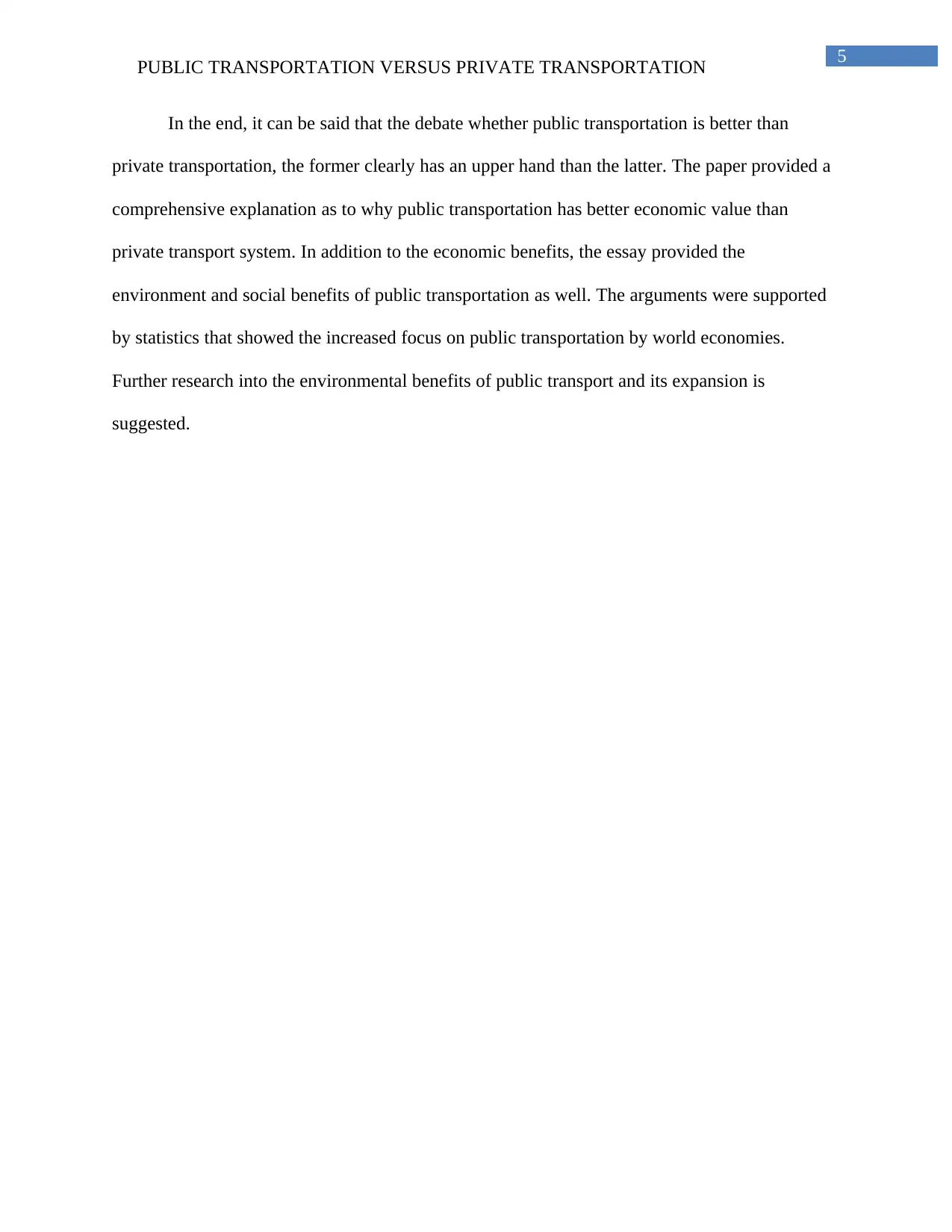
5
PUBLIC TRANSPORTATION VERSUS PRIVATE TRANSPORTATION
In the end, it can be said that the debate whether public transportation is better than
private transportation, the former clearly has an upper hand than the latter. The paper provided a
comprehensive explanation as to why public transportation has better economic value than
private transport system. In addition to the economic benefits, the essay provided the
environment and social benefits of public transportation as well. The arguments were supported
by statistics that showed the increased focus on public transportation by world economies.
Further research into the environmental benefits of public transport and its expansion is
suggested.
PUBLIC TRANSPORTATION VERSUS PRIVATE TRANSPORTATION
In the end, it can be said that the debate whether public transportation is better than
private transportation, the former clearly has an upper hand than the latter. The paper provided a
comprehensive explanation as to why public transportation has better economic value than
private transport system. In addition to the economic benefits, the essay provided the
environment and social benefits of public transportation as well. The arguments were supported
by statistics that showed the increased focus on public transportation by world economies.
Further research into the environmental benefits of public transport and its expansion is
suggested.
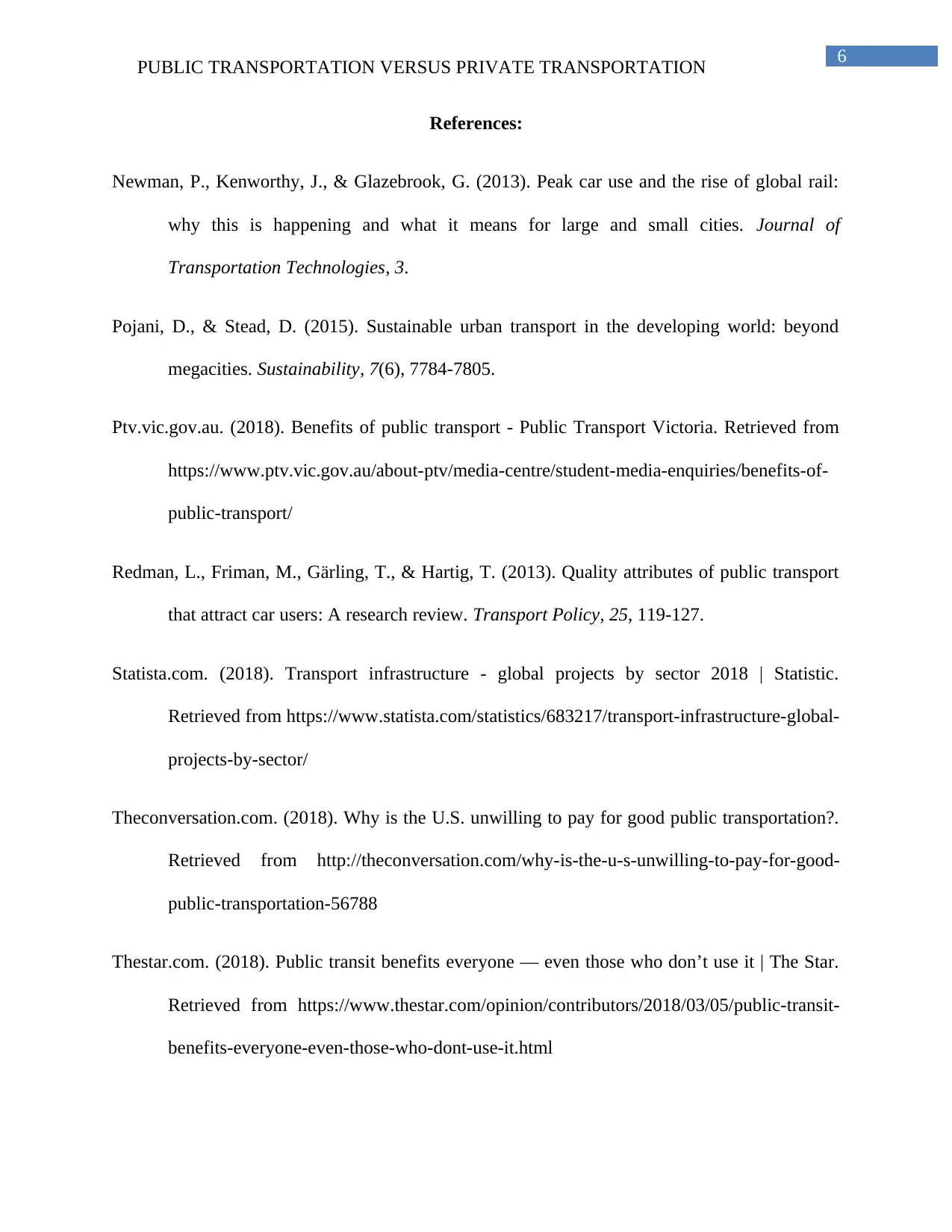
6
PUBLIC TRANSPORTATION VERSUS PRIVATE TRANSPORTATION
References:
Newman, P., Kenworthy, J., & Glazebrook, G. (2013). Peak car use and the rise of global rail:
why this is happening and what it means for large and small cities. Journal of
Transportation Technologies, 3.
Pojani, D., & Stead, D. (2015). Sustainable urban transport in the developing world: beyond
megacities. Sustainability, 7(6), 7784-7805.
Ptv.vic.gov.au. (2018). Benefits of public transport - Public Transport Victoria. Retrieved from
https://www.ptv.vic.gov.au/about-ptv/media-centre/student-media-enquiries/benefits-of-
public-transport/
Redman, L., Friman, M., Gärling, T., & Hartig, T. (2013). Quality attributes of public transport
that attract car users: A research review. Transport Policy, 25, 119-127.
Statista.com. (2018). Transport infrastructure - global projects by sector 2018 | Statistic.
Retrieved from https://www.statista.com/statistics/683217/transport-infrastructure-global-
projects-by-sector/
Theconversation.com. (2018). Why is the U.S. unwilling to pay for good public transportation?.
Retrieved from http://theconversation.com/why-is-the-u-s-unwilling-to-pay-for-good-
public-transportation-56788
Thestar.com. (2018). Public transit benefits everyone — even those who don’t use it | The Star.
Retrieved from https://www.thestar.com/opinion/contributors/2018/03/05/public-transit-
benefits-everyone-even-those-who-dont-use-it.html
PUBLIC TRANSPORTATION VERSUS PRIVATE TRANSPORTATION
References:
Newman, P., Kenworthy, J., & Glazebrook, G. (2013). Peak car use and the rise of global rail:
why this is happening and what it means for large and small cities. Journal of
Transportation Technologies, 3.
Pojani, D., & Stead, D. (2015). Sustainable urban transport in the developing world: beyond
megacities. Sustainability, 7(6), 7784-7805.
Ptv.vic.gov.au. (2018). Benefits of public transport - Public Transport Victoria. Retrieved from
https://www.ptv.vic.gov.au/about-ptv/media-centre/student-media-enquiries/benefits-of-
public-transport/
Redman, L., Friman, M., Gärling, T., & Hartig, T. (2013). Quality attributes of public transport
that attract car users: A research review. Transport Policy, 25, 119-127.
Statista.com. (2018). Transport infrastructure - global projects by sector 2018 | Statistic.
Retrieved from https://www.statista.com/statistics/683217/transport-infrastructure-global-
projects-by-sector/
Theconversation.com. (2018). Why is the U.S. unwilling to pay for good public transportation?.
Retrieved from http://theconversation.com/why-is-the-u-s-unwilling-to-pay-for-good-
public-transportation-56788
Thestar.com. (2018). Public transit benefits everyone — even those who don’t use it | The Star.
Retrieved from https://www.thestar.com/opinion/contributors/2018/03/05/public-transit-
benefits-everyone-even-those-who-dont-use-it.html
Paraphrase This Document
Need a fresh take? Get an instant paraphrase of this document with our AI Paraphraser

7
PUBLIC TRANSPORTATION VERSUS PRIVATE TRANSPORTATION
Uitp.org. (2018). Monthly focus: The economic impact of public transport. Retrieved from
https://www.uitp.org/news/monthly-focus-economic-impact-public-transport
PUBLIC TRANSPORTATION VERSUS PRIVATE TRANSPORTATION
Uitp.org. (2018). Monthly focus: The economic impact of public transport. Retrieved from
https://www.uitp.org/news/monthly-focus-economic-impact-public-transport
1 out of 8
Related Documents
Your All-in-One AI-Powered Toolkit for Academic Success.
+13062052269
info@desklib.com
Available 24*7 on WhatsApp / Email
![[object Object]](/_next/static/media/star-bottom.7253800d.svg)
Unlock your academic potential
© 2024 | Zucol Services PVT LTD | All rights reserved.





